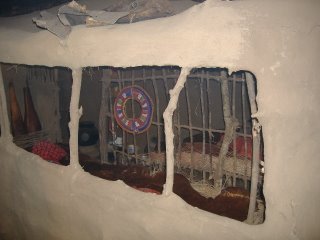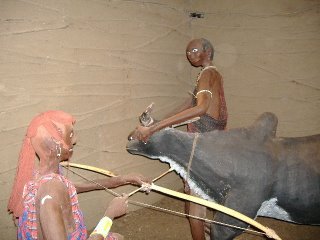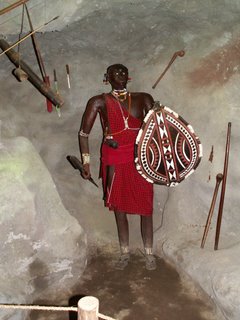Maasai Cultural Museum at Meserani

Our guide was called Martin, a Maasai man wrapped in the now-familiar red, who introduced himself as a morani, a warrior. He led us into the dim, cave-like corridors of the museum.
Inside was a fascinating collection of scenes from Maasai life cleverly made from painted papier-mache and chicken-wire and set in surreal tableaus. The air swirled with clay dust and the floor was dirt. No Disneyesque tourist attraction this!

There was a near life-size model of a Maasai home made of mud and grasses and dung with the walls partially cut away so you could see inside. The women are the builders of homes and they are only built as high as the woman can reach.

One of the scenes showed the bleeding of a cow with a bow-and-arrow sort of tool. Cattle's blood is one of the staples of the Maasai diet and this blood-letting is a delicate process so no lasting harm comes to the cow. I remember as a child listening to a Kenyan visitor to our school and being fascinated by the tale of this tradition. I could scarcely believe it was true!
The Maasai also eat the meat and milk from cattle. Cattle are very important to the lifestyle of the Maasai.

Other exhibits showed women giving birth, warriors in their traditional costumes, and an elderly Maasai man apparently in a drunken stupor lying under a tree, an empty drink vessel near his outstretched hand. I think the man was supposed to be under the influence of some sort of ceremonial narcotic, but the scene made me blink a little.

In this same exhibit a long wooden keg hung from the same tree. I've seen these on trees on this trip and Martin informed me they were bee-hives for harvesting honey.
The exhibit showing a young boy being circumcised elicited some raised eye-brows from the group, but Martin seemed eager to explain its cultural significance.
Martin was twenty-two years old when he was circumsized and so I am sure he has a clear memory of it as no anesthesia is used.
He emphasized that it is very shameful to cry during the operation, or even to show evidence of any discomfort or emotion. A girl might be expected to cry during their circumcision, but not a boy.

He showed us the tight-lipped, impassive look a boy might wear on his face and then a look of deep, pained concentration which was very convincing. A man must be circumsised before he is able to marry.
Lizzie piped up with some thoughtful questions for the reasons behind this sort of tradition, but to sum up Martin's answers: "It's tradition."

We also passed through a room full of everyday articles such wooden spears and shields, leather carrying-bags, drinking cups made from cow horns, and a fly-swatter made from the tail of a wildebeest.



0 Comments:
Post a Comment
<< Home